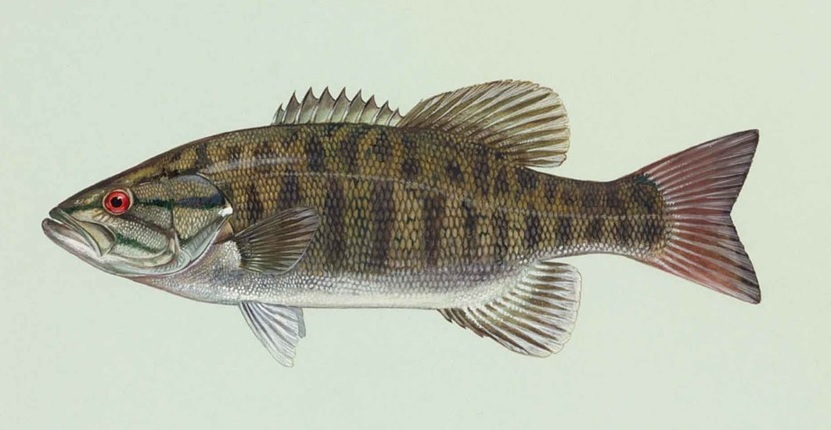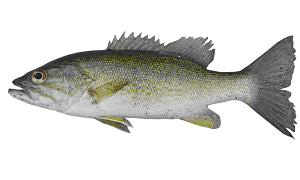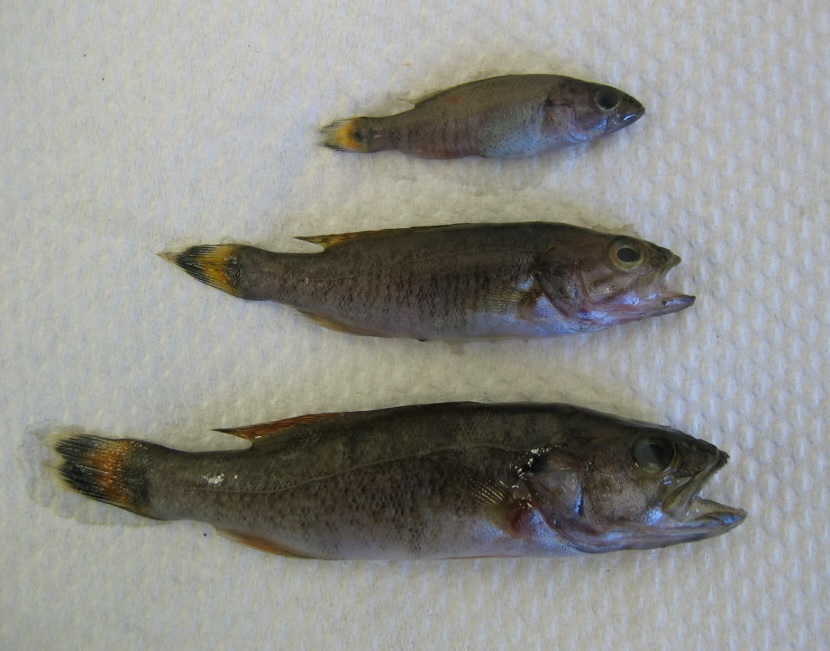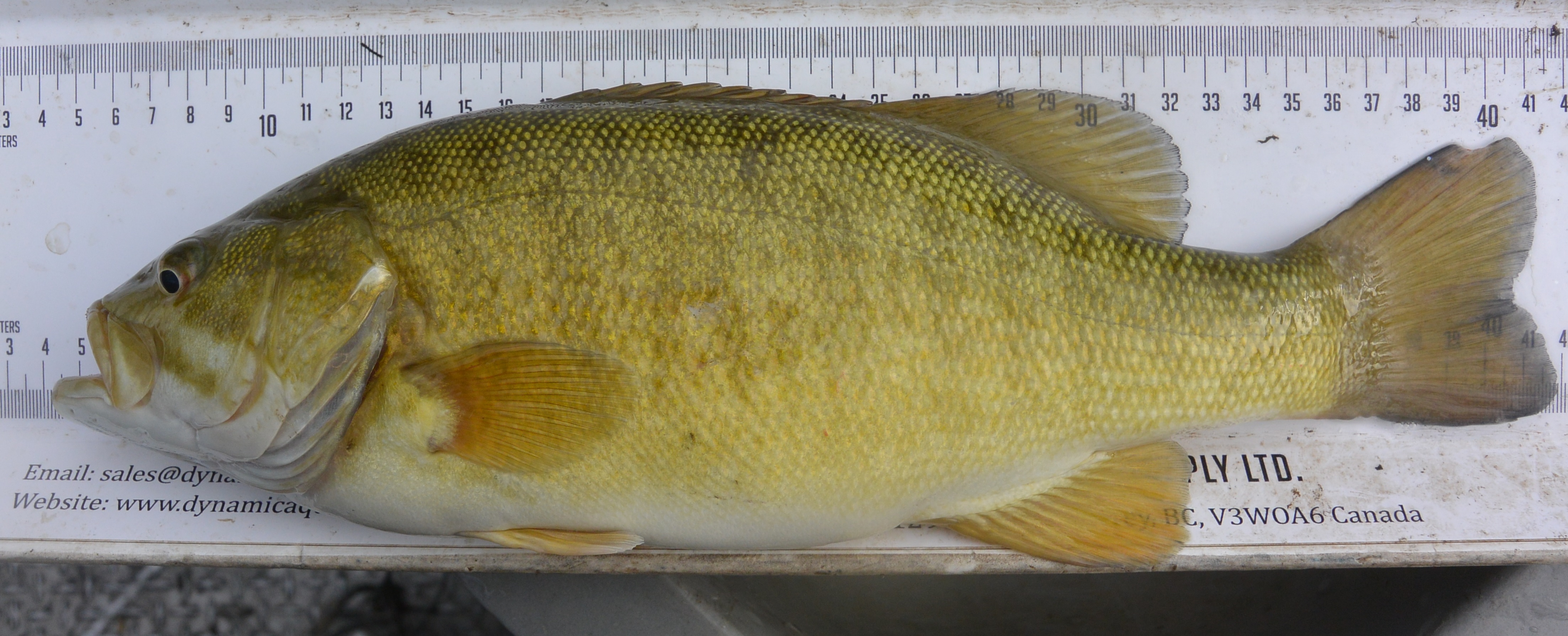Smallmouth Bass
Micropterus dolomieu
Learn about Smallmouth Bass, including its identifying features, habitat, spread, impacts and our response.
The Smallmouth Bass (Micropterus dolomieu) is a freshwater fish and a member of the sunfish family. They are a top predator that eat a wide range of prey, including insects, crayfishes, fishes, tadpoles, frogs and plant material. They can be invasive when introduced to new lakes and rivers.
On this page
Identifying features
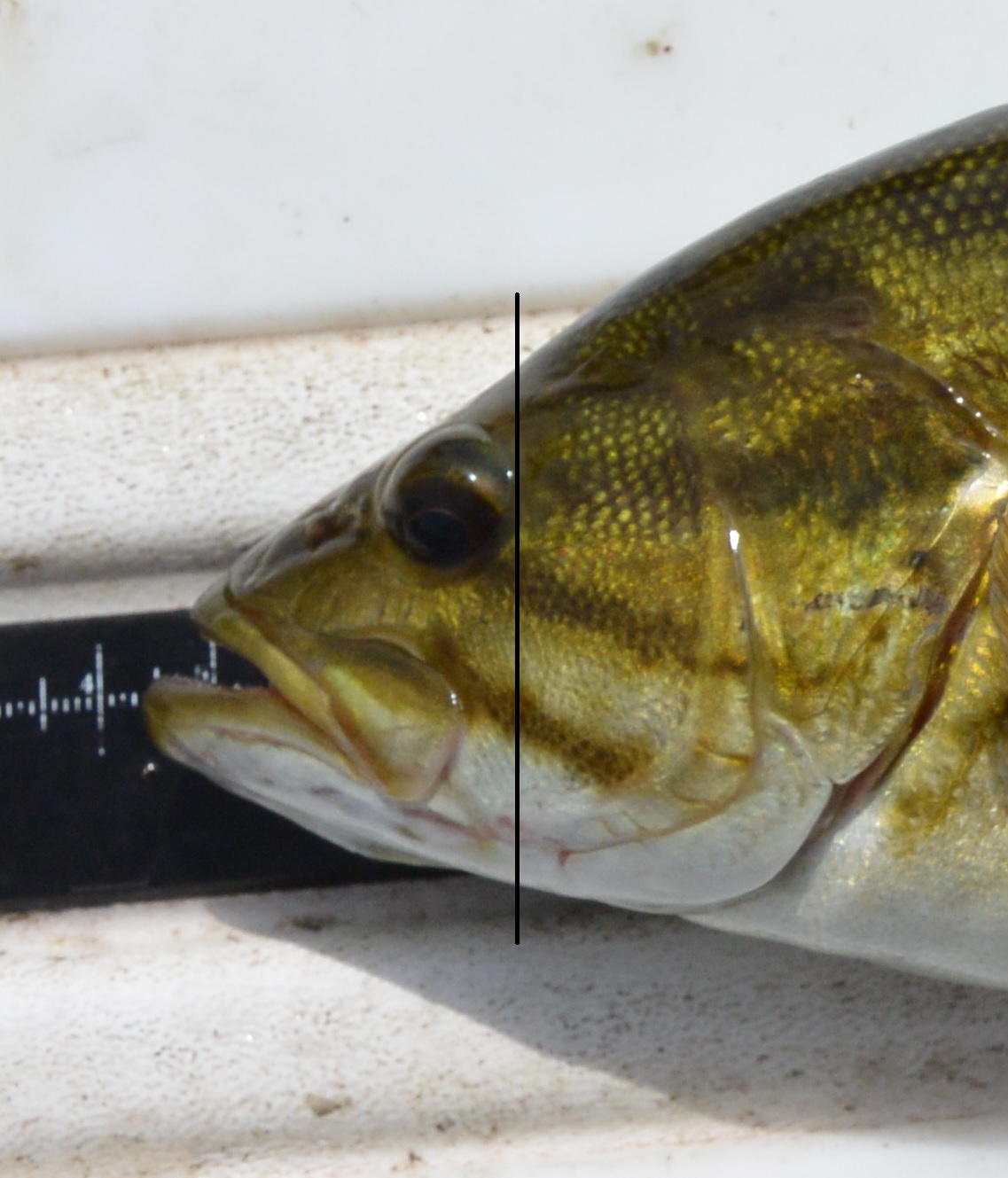
The jaw of the Smallmouth Bass does not extend past the eye. Dark bars radiate back from the eye and one bar radiates from the eye to the snout.
You can identify Smallmouth Bass by their:
- upper jaw does not extend past the eye
- dark bars radiating back from the eye and one bar radiates from the eye to the snout
- eye that is sometimes red in colour
- laterally compressed body (more than the Largemouth Bass)
- sides that have golden flecks on most scales
- sides that have vertical bars that are sometimes broken (ranging from very visible to slightly visible)
- joined dorsal fins that appear as one (unlike the Largemouth Bass, which has a more obvious separation between dorsal fins)
The body colour of Smallmouth Bass changes with size, condition and habitat. It will be darker with pronounced, contrasting markings in clear water and lighter, with blurry markings in cloudy water.
Where is it invasive?
In Canada, Smallmouth Bass has been confirmed as introduced in:
- southern British Columbia, including:
- many lakes in southern Vancouver Island
- Saltspring Island
- Columbia River system
- small number of systems in the Fraser drainage
- most of the lowland Okanagan lakes
- in the Kootenays
- south-eastern Saskatchewan
- the south end of Lake Winnipeg in Manitoba
- Ontario, inland lakes as far north as Timmins
- southern Quebec
- southern and western New Brunswick
- southern Nova Scotia
Distribution
Smallmouth Bass is native to the fresh waters of eastern-central North America. The original Canadian distribution of Smallmouth Bass was restricted to the Great Lakes – St Lawrence system with the exception of Lake Superior.
Historically, introductions of Smallmouth Bass to other parts of Canada for recreational fishing were allowed until the late 1900s. Smallmouth Bass is a popular sport fish, but can be invasive when introduced to new lakes and rivers. Recent spread is a result of accidental introductions when used as live bait and unauthorized transfers between waterbodies for recreational fishing.
In some areas, Smallmouth Bass is considered established and is managed for recreational fishing. With the appropriate fishing licences, it is legal to fish for Smallmouth Bass in these areas. Outside of these areas, Smallmouth Bass are considered invasive. Each province has different management approaches. For detailed information on the status of Smallmouth Bass in your region, contact provincial authorities or your local DFO office.
Habitat
Smallmouth Bass prefer cool water and are usually found near shoals or submerged logs and in moderately shallow, rocky and sandy areas.
It is seldom found in dense aquatic vegetation (which are favoured by Largemouth Bass). Therefore, the habitats of Largemouth and Smallmouth Bass don’t often overlap, even if both species inhabit the same lake.
Impacts
Smallmouth Bass is a top predator that can dramatically change the native food web after introduction to a new waterbody. When established in new areas Smallmouth Bass can:
- change the food web by reducing the amount of prey available to native fish
- reduce native fish populations or cause them to alter their behaviour
There are many factors that make Smallmouth Bass a successful invader, including their:
- ability to produce many offspring
- low habitat overlap with other predators
- small size at which they begin eating other fish
Management
Management of Smallmouth Bass in Canada is complex. In parts of the country it is native, in other parts it is well established and managed for sport fisheries and in other parts it is invasive and managed as such. The boundaries between these different management strategies are not always clearly defined and in most provinces or regions this species is managed on a case-by-case basis.
In many provinces/regions, inland waters are delegated to the provinces, meaning the provinces take the leadership role in managing Smallmouth Bass (either as native, invasive or sportfish), with the extent of DFO involvement varying across regions, depending on partnership agreements made between the different levels of government.
Related links
Reports
- Scoping the distribution of Smallmouth Bass (Micropterus dolomieu) in the Miramichi River Watershed in 2019 and 2020 using environmental DNA
- Biological synopsis of Smallmouth Bass (Micropterus dolomieu)
- Biological risk assessment for Smallmouth Bass (Micropterus dolomieu) and Largemouth Bass (Micropterus salmoides) in British Columbia
- Proceedings of the National Workshop on Six Invasive Fishes Risk Assessment in British Columbia
- A Review of Yellow Perch (Perca flavascens), Smallmouth Bass (Micropterus dolomieu), Largemouth Bass (Micropterus salmoides), Pumpkinseed (Lepomis gibbosus), Walleye (Sander vitreus) and Northern Pike (Esox lucius) Distributions in British Columbia
- Science advice from a Risk Assessment of Smallmouth Bass (Micropterus dolomieu) in British Columbia
- Potential impact of Smallmouth Bass introductions on Atlantic Salmon: A Risk Assessment
- Smallmouth Bass (Micropterus dolomieu) invasion of Gulf Region Rivers: Evaluating the Impact on Atlantic Salmon (Salmo salar) Populations
- Atlantic Salmon (Salmo salar) and Smallmouth Bass (Micropterus dolomieu) Interactions in the Magaguadavic River, New Brunswick
- Geographic distribution of Smallmouth Bass, Micropterus dolomieu, in Nova Scotia: history of early introductions and factors affecting current range
- Risk assessment of Smallmouth Bass (Micropterus dolomieu) introductions to rivers of Gulf Region with special consideration to the Miramichi River (N.B.)
- Results of a Control and Eradication Program for Illegally Introduced Non-endemic Smallmouth Bass (Micropterus dolomieu) in Miramichi Lake, New Brunswick, 2010
- Review of control and eradication activities in 2010 to 2012 targeting Smallmouth Bass in Miramichi Lake, New Brunswick
- Results of a multi-year control and Eradication Program for Smallmouth Bass (Micropterus dolomieu) in Miramichi Lake, New Brunswick, 2011-2012
- Review of the control and monitoring activities for Smallmouth Bass (Micropterus dolomieu) in Miramichi Lake, New Brunswick, from 2009 to 2017
- Review of elements of proponent application to use rotenone for the purpose of eradicating Smallmouth Bass (Micropterus dolomieu) from Miramichi Lake, New Brunswick
Photo gallery
- Date modified:
